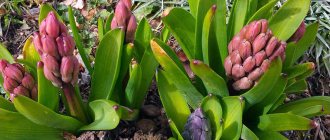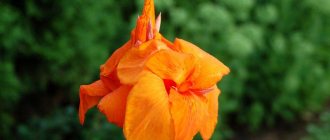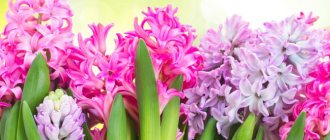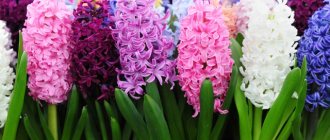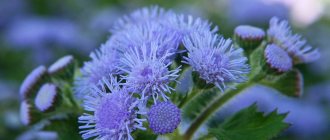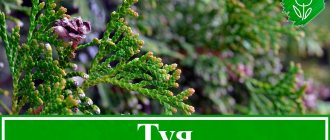Author: Elena N. https://floristics.info/ru/index.php?option=com_contact&view=contact&id=19 Category: Garden plants Published: February 28, 2019Last edits: January 13, 2021
- When to plant
- Growing conditions
- How and when to collect seeds
- Bergenia stracheyi (Вergenia stracheyi = Вergenia gorbunowii)
- Medicinal properties
The herb bergenia, or bergenia (lat. Bergenia), forms a genus of perennials of the Saxifraga family. These perennial herbs grow in the temperate zone from Korea and China to the countries of Central Asia, settling in rock cracks or on rocky soil. Bergenia was introduced into culture in the middle of the 18th century under the name “saxifrage thick-leaved,” but then it was taken into a separate genus and given a Latin name in honor of the German botanist Carl August von Bergen. Scientists know 10 types of bergenia, some of them are grown in cultivation. In addition, breeders have developed dozens of varieties and hybrids of bergenia.
Planting and caring for bergenia
- Planting: sowing seeds in a box for seedlings - before winter, picking seedlings - in early June, planting seedlings in open ground - in early August. The strongest seedlings can be planted in open ground in early June without picking.
- Flowering: timing depends on the species: some can bloom as early as the end of April. Flowering lasts about one and a half months.
- Lighting: partial shade, but can also be grown under diffused light.
- Soil: light, loose, moist, slightly alkaline.
- Watering: if the season is dry, the first watering is done during budding, then during flowering, then after another 2-3 weeks. If precipitation is normal, watering is not necessary.
- Fertilizing: in early spring after pruning, then two weeks after flowering, complex mineral fertilizers in liquid form are applied to the soil.
- Reproduction: by seeds and dividing the bush.
- Pests: slobbering pennies and nematodes.
- Diseases: ramulariasis.
- Properties: the rhizome of the plant has medicinal properties. Preparations made from it have anti-inflammatory, hemostatic, wound-healing, antimicrobial, diuretic, and astringent effects.
Read more about growing bergenia below.
Care
Caring for bergenia is not at all problematic. In autumn, dry inflorescences should be removed, and overwintered leaves should be cut off in spring. In the first season after planting bergenia (no matter by seedlings or dividing the bush), the ground should be mulched. It should be watered only as needed, without allowing the soil to dry out. The healing healer is responsive to the application of mineral supplements. In the spring it can be fed with universal fertilizer: “Kemira Lux”, and in the fall it can be watered with a solution of superphosphate fertilizer at the rate of 20 g per bucket for watering 1 m² of soil.
Botanical description
The genus Badan includes evergreen perennial and annual plants from 6 to 35 cm in height with a thick horizontal rhizome, basal rosettes of large leathery, shiny dark green leaves on long petioles and goblet-shaped flowers of white, red or pink, collected in dense panicles , blooming in late spring or early summer. One inflorescence can have up to 120 flowers. The fruit of the bergenia is a capsule.
Bergenia in landscape design looks very impressive against the background of stones next to variegated and narrow-leaved crops - hostas or phlox. We will tell you everything about how to plant and care for bergenia in the open ground, as well as what the medicinal properties of bergenia are and contraindications.
Landing Features
Bergenia has a superficial root system, and therefore you should not make deep holes when planting. The depth of the planting hole should be from 6 to 20 cm. The size of the hole depends on the chosen method of propagation. Be sure to place a little sand at the bottom of the planting hole to act as drainage.
The soil mixture for bergenia should contain peat or compost mixed with garden soil in equal quantities.
The distance between adjacent bergenias should be at least 40 cm. At the end of planting, compact the soil and water it.
Growing bergenia from seeds
How to sow seeds
Bergenia is sown before winter. Place flower soil in the box, make grooves 5 mm deep in it at a distance of 3 cm from each other and spill them with warm water, place bergenia seeds in them and seal them. The box is taken out into the yard and placed under the snow. At the beginning of March, a box with crops is brought indoors and kept in partial shade at a temperature of 18-19 ºC.
- Blackleg - 4 conditions, the fulfillment of which will help you forget about this disease on seedlings forever
Seedling care
Shoots will begin to appear in three weeks. Caring for bergenia seedlings involves loosening and moistening the soil as its top layer dries, ventilating the room and thinning the seedlings. When a green crust or plaque forms on the surface of the substrate, you need to carefully loosen the soil, because this phenomenon indicates that oxygen has stopped flowing to the roots of the seedlings as a result of excessive watering.
Bergenia pick
In May, bergenia seedlings are planted in a box at a distance of 5-7 cm from each other in a row with a row spacing of 15 cm. A couple of weeks before planting in open ground, hardening procedures begin: the seedlings are taken out to the balcony or terrace every day, gradually increasing the duration of the session. When the seedlings can spend a whole day in the fresh air, they are planted in open ground.
Badan in landscape design
Bergenia flowerbed in a garden plot
The decorative flower looks great in the design of gardens, flower beds and stone compositions. Thanks to the creeping form of the root system, the plant densely covers the ground, preventing weeds and other harmful grasses from developing.
Bergenia looks great both as part of a flower bed with other ornamental crops, and as a single plant, covering, for example, an uneven layer of soil with a beautiful, uniform carpet of green leaves.
Among other things, ease of care and unpretentiousness to the composition of the soil makes it possible to grow bergenia in almost any conditions. It can grow both in shade, partial shade, and in areas illuminated by sunlight. The main thing is to adjust the principles of basic plant care in accordance with the conditions of its maintenance.
Bergenia gets along well with the following decorative flowers in the flowerbed:
- astilbe;
- hellebore;
- fern;
- lungwort;
- juniper and others.
Not the best combination for bergenia would be lilies of the valley, periwinkle and other creeping plants that are short in stature. They will suppress each other, preventing them from growing. Flowering will develop poorly and the result of such a tandem will not please the gardener.
Planting bergenia in open ground
When to plant
Planting and caring for bergenia is not at all difficult - the plant is unpretentious and resistant to cold. Bergenia is planted in early August. Some gardeners prefer not to pick seedlings, but to immediately plant them in open ground in early June. But sometimes it seems that the seedlings are still too weak for the garden, so plant only the most developed seedlings in June, and pick up the rest and move their planting to August.
How to plant
The bergenia plant has a weak, horizontal root system, so it prefers light, loose, moist and slightly alkaline soils. The roots of the plant often protrude from the ground, and to prevent them from overheating in the sun, choose a place for the plant in partial shade, on the north, north-west or north-east side of the site.
If this is not possible, and you are forced to plant the plant in a sunny area, mulch the soil around the bergenia after planting - this measure will protect the soil from drying out and the bergenia root from overheating. And keep in mind that bergenia does not tolerate even short-term stagnation of water in the roots.
Make holes in the soil 6-8 cm deep, arranging them in a checkerboard pattern 40x40 cm. Throw a handful of sand at the bottom of each hole for drainage, then roll over the seedling with a lump of earth and dig it in. After planting, water the seedlings. Bergenia develops very slowly, so be patient and care. Bergenia blooms from seeds in the third or fourth year.
Pest and disease control
Bergenia is almost not affected by pests. This is due to its chemical composition.
One of the pests of bergenia is the slobbering pennitsa, which likes to breed in its shade. Chemicals are used to combat it.
Also, the bergenia plant can be affected by nematodes, which are roundworms. When they multiply massively, the plant dies. When it is transplanted, nematode eggs remain on the roots. The area where they settled must be treated with chemicals and no plants should be planted on it for at least a year.
The main disease in bergenia is rotting of the rhizome, which is caused by fungal pathogens. This disease can affect the plant in clay soils with existing poor water drainage, as well as on heavy substrates.
Read how to properly plant heather in the garden in this article.
You can also read about popular varieties of freesia, its planting and care.
How to make a rock garden with your own hands - .
Caring for bergenia in the garden
Growing conditions
Growing and caring for bergenia usually does not involve any problems. In the spring, after the snow has melted, remove the leaves from the plants that have been damaged during the winter - not all, but only the damaged ones, cut off heavily overgrown shoots and apply complex mineral fertilizers. The next feeding is carried out two weeks after the bergenia blooms, when new leaves begin to grow. Kemira-combi is used for this purpose by dissolving one tablespoon of the drug in 10 liters of water. This amount should be enough for 2 m² of land.
Caring for bergenia involves timely watering of the plant. The first time the soil is moistened during budding, then during flowering and 2-3 weeks after it, but only in the case of a complete absence of rain. If it is summer with precipitation, there is no need to water the bergenia. To protect the soil from overheating and drying out under natural conditions, dying leaves of bergenia are used, but in culture, to maintain the decorative appearance of the area, dead leaves are torn off (precisely, they are torn off, without leaving cuttings), and to protect the root system, the soil under the bushes is mulched.
Propagation of bergenia
Bergenia is propagated by seeds and vegetatively by dividing the bush. We have already told you about growing bergenia from seeds. As it grows, bergenia forms new rosettes with roots lying close to the surface, so digging them out without damaging the mother rhizome is very easy. Separate rosettes with heels from healthy, developed, middle-aged plants with large leaves. This is done after flowering - from May to August. Each segment of the rhizome must have at least three buds. The leaves are removed from the cuttings, leaving only 2-3 of the youngest leaves.
The divisions are planted in prepared holes to a depth of 3-5 cm at a distance of 30-40 cm from each other. Cuttings root easily. In the first year, the rooted plant grows a rosette, and bergenia will bloom in the second or third year.
Transfer
Bergenia can grow in one place for several decades; it does not like frequent transplants. Bergenia grows in breadth and can become aggressive, taking over territories intended for other plants. Therefore, every 5-6 years the bergenia is transplanted. When to replant bergenia? Simultaneously with dividing the bush - in the first half of September. Plant parts are planted at a distance of at least 30 cm from each other. The first two weeks after planting, the plants are watered abundantly.
Pests and diseases
Just like astrantia, tenacious and other unpretentious garden flowers, bergenia is very resistant to diseases and harmful insects, but unfavorable growing conditions, namely high soil moisture, can provoke the development of fungal infections. In such cases, bergenia can be affected by ramulariasis. The disease can be diagnosed by brown spots with a reddish border on the upper side of the leaves of the plant, while a slightly noticeable whitish coating appears on the lower side. As the disease develops, the affected leaves dry out.
Diseased leaves should be removed, and the plant should be treated with Fundazol or other preparations containing copper - Bordeaux mixture, copper oxychloride or copper sulfate.
- How to care for daylilies in a flower bed
Among the pests, bergenia growing in partial shade can be affected by slobbering pennies and nematodes. Slobbering pennies can be dealt with with Actellik or Aktara by carrying out a two-stage treatment of the plant at intervals of a week on a dry day at a temperature of no lower than 21 and no higher than 28 ºC, but it will take a long time to fight the nematode: you need to dig up the bush, keep the rhizome for half an hour in a strong solution of potassium permanganate, then why the bush should be transplanted to another place, and the soil in which the nematodes have grown needs to be treated with insecticides several times, but it will be possible to grow any plant in this place only after a year.
Reproduction methods
Bergenia propagates by seeds, rosettes and pieces of rhizome. The first method is the most problematic, since the seeds are small - 1.5–2.0 mm, the seedlings will be the same and will require a lot of attention.
If you already have bergenia growing, you can collect seeds from your bushes. They ripen towards the end of summer in boxes formed after flowering. The boxes should be dry yellow or brown. Lay them out at home on a large piece of paper or newspaper. As they ripen and dry out, they will open, the seeds will begin to spill out, and can be collected. If there is no bergenia or it has not formed an ovary, then the seeds, among others, can be found in a gardening store.
Bergenia seeds are very small
Sowing of seedlings begins in March - May:
- Fill boxes or containers 7–10 cm deep with drainage holes with any nutritious soil mixture, you can use a universal one from the store.
- Moisten and tamp the soil, spread the seeds at a distance of 2–3 cm and sprinkle them with a very thin layer (up to 5 mm) of loose and moist soil. Do not water from above, otherwise the seeds will go deep with the water and will not germinate.
- Cover with film and keep at a temperature of about +20 °C.
- Shoots will appear in 3-4 weeks! All this time, you need to open the bowl with the seeds every day, ventilate and moisten with a sprayer if necessary.
- Keep the emerging seedlings in a bright window, continue to moisten the soil, do not overwater.
- When rosettes of 3–4 leaves grow, pick them out into separate pots.
Bergenia seedlings after picking
- Plant in open ground in the second half of summer. Until then, water the seedlings and feed them with fertilizer for seedlings (Fertika, Agricola, Clean Leaf, etc.) every 7–10 days.
Bergenia from seeds grows very slowly the first two years, and blooms in the third.
The seeds are sown directly into the garden bed before winter, but in the spring the seedlings can get lost among the weeds. You will have to monitor their appearance in order to weed and water them on time.
It is much easier to plant this plant with a rosette or a piece of rhizome. The root of the bergenia is branched and spreads along the surface, so it is not difficult to determine what and how to take for propagation.
The rhizome of bergenia lies on top of the ground, branches
A rosette is a young, not yet flowering, branch that has grown away from the mother plant. It has its own piece of root and leaves. Rosettes can be separated and planted from May to August.
Bergenia rosette - a young twig with leaves and part of the rhizome
In September, when digging rhizomes to prepare medicine, you can select and plant pieces of root 15–20 cm long with three buds.
Fresh bergenia root can be dried for medicinal purposes, or you can plant it
Bergenia after flowering
How and when to collect seeds
Bergenia produces many seeds, the size of which is approximately 2 mm. Choose the largest and most beautiful inflorescence, wait until the flowers begin to fade, and put a gauze bag on the inflorescence so that the ripened seeds do not spill onto the ground. The seeds are collected in September: the inflorescence is cut off below the bag, transferred to a ventilated dry room, dried for several weeks, the seeds are shaken out of the flowers, cleaned and stored.
Preparing for winter
Some types and varieties of bergenia, as well as young plants, may suffer from frosts - such bergenia in the fall should be covered with dry leaves or covered with spruce branches. But the types and varieties of bergenia, adapted to the conditions of the middle zone, winter well without shelter. Do not trim withered and dried leaves in the fall - this can be done in the spring.
What are the problems with transplantation?
Bergenia does not plague its owners with whims: it grows in one place for a long time and without difficulties, and since it rarely gets sick, preventive treatments do not need to be carried out. Those conditions that are best suited for perennials are usually disastrous for pests and infections, so it is very important to give the plant the opportunity to fully develop.
Problems that may appear in a new location for plantings:
- Young specimens grow very slowly. A transplanted division will have 1-2 leaves released by the end of the season, with which it will go into winter - no reason for concern, nor is the lack of flowering this and next season. Often the perennial blooms magnificently only in the third year after transplantation, so do not carry out frequent transplants, because of which growth slows down in the new place and there are no buds for a long time. You shouldn’t often replant bergenia unnecessarily, because it takes a long time to get rid of it.
- The absence of flowering in an overgrown plant makes it necessary to check compliance with the rules of agricultural technology. Possible causes include lack of sunlight and excessive shade.
- Yellow, limp leaves indicate stagnant moisture and acidified soil, which causes the roots to rot. The problem lies in the fact that when transplanting into loam, drainage was not provided. In this case, treat the roots with a solution of potassium permanganate, removing the damaged ones, and transplant the rosettes to a suitable drained place.
Important! To curb the horizontal spread and aggression towards neighbors of massive bergenia specimens, limit it to a border or decorative stone.
Its unpretentiousness and versatility in use have earned the perennial the love of ordinary flower growers and eminent breeders. With minimal care and favorable conditions, gorgeous leaves, a variety of species and the beauty of flowers become the highlight of a shady area, and you already know the rules for placement and replanting.
Types and varieties
The following types and varieties of bergenia are grown in culture:
Bergenia stracheyi (Вergenia stracheyi = Вergenia gorbunowii)
In nature it grows on wet rocks of Central Asia, Afghanistan, the Himalayas and China, sometimes it is found at altitudes of up to 3000 m above sea level. At first, this species was named after the leader of the expedition to the Western Pamir region, Gorbunov, but later it was given a different name. Badan Strechi is a living relic. It has ovate, oblong, glossy, ciliated leaves with rough teeth along the edge. The leaves are 8-10 long and 3-5 cm wide. They are well preserved under snow. Lilac-pink or white flowers up to 15 mm long on peduncles up to 40 cm high are collected in racemes. Streche bergenia blooms in July-August.
The best varieties of this species:
- Belvedere is a miniature plant up to 20 cm high with leaves 4-6 cm long and white flowers that gradually turn pink;
- Beethoven - a variety up to 40 cm high with snow-white flowers, pink peduncles and brown calyxes;
- Alba is a natural form with white flowers.
Bergenia thick-leaved (Bergenia crassifolia)
Aka medicinal bergenia, aka Mongolian tea, aka Chagyr tea, aka early flower. This amazing plant grows in Transbaikalia, Altai, Sayan Mountains, Kazakhstan, Northern Mongolia, China and Korea, choosing rocky slopes and cedar forests at an altitude of 700 to 2500 m above sea level.
It is an evergreen herbaceous perennial with a powerful creeping and branched rhizome and shoots of two types - rosette vegetative and flowering leafless, reaching a height of 40 cm at fruiting. The leaves of the vegetative shoots are large, leathery, glossy, obovate, bright green in color, becoming fiery red hue.
Bell-shaped flowers with white, pink-lilac or lilac-purple petals up to 12 mm long are collected in dense inflorescences. Flowering begins in June and lasts 3-4 weeks. They use bergenia for tanning leather, and for tea they collect old, withered leaves that have overwintered under the snow. The best decorative varieties of thick-leaved bergenia are:
- Senor - a bush up to 40 cm high with lilac-pink flowers;
- Hydroruspe is a plant up to 60 cm high with pale pink flowers collected in inflorescences up to 20 cm long. The flowering of this variety lasts almost two months;
- Purpurea is a bush up to half a meter high, with purple-red flowers up to 1 cm in diameter.
Bergenia (Bergenia cordifolia)
Plant up to 40 cm high, an intraspecific variety of bergenia thick-leaved. The leaf of Bergenia cordifolia is round, coarse in texture, dark green in color. Bell-shaped, deep pink or lilac flowers, collected in inclined racemes, bloom in May. There are varieties with lavender and white flowers. The plant has been in cultivation since 1779;
Hissar bergenia (Bergenia hissarica)
Endemic to the Gissar Range, a rare relict species. The rhizome of plants of this species is powerful, the leaves are rosette, basal, obtuse, oblong, obovate, glabrous, matte, densely ciliated along the edge. Peduncle up to 20 cm high. White or barely pinkish flowers are collected in 6-8 pieces in a one-sided brush;
Hybrid bergenia (Bergenia x hybrida)
This species includes the most commonly grown hybrids:
- Abenglut is a bush up to 30 cm high with bright green leaves that turn bronze-brown in autumn, and bright purple, sometimes double flowers;
- Frau Holle is a variety with snow-white flowers and marsh-colored leaves, the petioles of which become bright purple in cold weather;
- Schneekenigin is a plant up to 50 cm high with large round leaves with wavy edges and tall purple peduncles, on which large cup-shaped white flowers open, gradually turning pink. The variety is grown for cutting;
- Morgen Rothe is a variety that blooms twice per season with bright pink flowers collected in branched racemes;
- Baby Doll is a bush up to 30 cm high with beautifully shaped flowers of pale pink color, gradually turning into dark cream.
In addition to those described, bergenia hybrids Sieberlicht, Glockenturm, Ballouley, Bassingham White, Sunshade, Magic Giant, Walter Kinley, Sunningdale, Eroika, Pink Dragonfly and varieties named after great composers - Bach, Bizet, Bartok, Borodin, Brahms - are often grown in culture. .
In cultivation there are also types of bergenia ciliated, Pacific, Schmidt and Ugam.
- Brachychiton - care, photos, types
History of the origin of bergenia
In 1760, Carl Linnaeus, a German botanist, classic of biology and creator of the foundations of modern descriptive biological nomenclature, was sent an unknown herbaceous plant from St. Petersburg. According to the senders, the specimen was discovered in Siberia. Linnaeus, after careful study and comparison with already described crops, named it the thick-leaved saxifrage (Latin name - Saxifraga crassifolia).
A little later, the botanist Konrad Mench, continuing his work on plant classification, combined several types of crops. The genus was named Bergenia, in honor of another, no less famous biologist - von Bergen.
As it turned out later, the natural habitat of bergenia is quite wide. In Siberia, the plant is distributed in Altai, Buryatia, Chita, Kemerovo, and Irkutsk regions. Bergenia is also found in the south of Yakutia, Kazakhstan, in places in Primorye, widely in China, partly in Asia, Korea, Afghanistan and Mongolia.
Thanks to its long, up to several meters, thick rhizome, bergenia grows well in the most extreme places - on rocks, rocky slopes, in the subalpine zone, on glacial deposits - moraines. Good shade tolerance allows it to grow in forests with medium-close canopies.
There is an assumption that these amazing plants received the name “saxifrage” for their ability to grow among stones. When you see bergenia in some rocky crevice, it seems that the sprout, stubbornly making its way towards the sun, really broke the stone.
In 1928, a large scientific expedition led by the famous Soviet scientist N.P. conducted research in the Western Pamir region. Gorbunova. Quite unexpectedly, they discovered a plant whose appearance was very similar to bergenia. The intrigue that excited the scientific community was that there was no information about the growth of plants of the genus Bergenia in Central Asia before Gorbunov discovered the bergenia.
The plant was named “Badan Gorbunova”. At the moment, the species is included in another previously described species – Streča bergenia. As it turned out later, these plants are real relics. The closest relative of modern bergenia grew in the Pamirs about 2 million years ago. In those days, the climate was much warmer, and the Asian mountains were much lower. Over time, the mountains rose and the climate became more severe. However, the plant was able to survive. Single species are found in this area to this day and in appearance are practically no different from their ancient ancestors.
There are currently 10 known types of bergenia. Since the middle of the 13th century, bergenia has been actively cultivated. Garden forms are used to create landscape compositions. In Altai, local residents brew a tonic drink from bergenia leaves, which has a number of beneficial properties and is considered healing. Breeders are also actively working with bergenia. Culture is easy to change and interesting for experimentation.
As a garden plant, bergenia is little known in Russia. The plant is just beginning to gain popularity, but judging by the interest it arouses among flower growers, this will happen in the very near future.
Properties of bergenia - harm and benefit
Medicinal properties
The medicinal raw materials are the rhizome of bergenia, and its leaves, flowers and seeds. The above-ground parts of the plant contain flavonoids, tannins, arbutin, manganese, copper, iron and vitamins, and the roots contain tannins, resins, starch, and polyphenols.
In folk medicine, the medicinal properties of the plant's roots are used for enterocolitis, fibroids and cervical erosions, and malignant tumors. Bergenia is used to treat lung diseases, bleeding gums, flu, acute respiratory diseases, dermatosis, gastrointestinal diseases, articular rheumatism, hemorrhoids, fever and headaches.
Preparations based on bergenia have anti-inflammatory, antimicrobial, diuretic, hemostatic, wound-healing, astringent effects, strengthen capillary walls, constrict blood vessels, lower blood pressure, and increase heart rate.
Contraindications
Long-term use of bergenia preparations can cause constipation. Bergenia tincture is contraindicated for people with increased blood clotting. A decoction of the roots lowers blood pressure, so it is not recommended for use by people with hypotension.
Collection and preparation
Harvesting bergenia should only be done during the summer growing season, which lasts from June.
The rhizomes can be dug up with a small shovel or dug by hand, as they lie shallow. Then you need to clear the roots, soil, and aerial parts. The raw materials should be cut into pieces 15-20 centimeters long, withered, and dried slowly. The temperature should not exceed +50 degrees if dryers are used for these purposes. Don't rush too much. Since quick drying in the oven will lead to the fact that most of the tannins will be lost. On average, the drying process of raw materials takes up to 3 weeks. You can store harvested raw materials for up to 4 years. When harvesting rhizomes, you need to take care. So that up to 15 percent of the plant thickets are preserved in order to continue subsequent seed propagation. Experts advise re-harvesting rhizomes in the same place no earlier than after 10 years. When harvesting rhizomes, take care to preserve 15% of the thickets. Mongolian tea can be harvested again in the same place no earlier than after 10 years.
Application in medicine
Bergenia is actively used for medicinal purposes in a variety of fields of medicine. The rhizomes of this plant are used to make infusions and decoctions.
Decoctions of Mongolian tea are especially effective for bleeding, various infections, and liver ailments. The decoction can be used in the treatment of dysentery, combined with antibiotics. Externally, a decoction of bergenia is used to wipe the skin for furunculosis and other skin ailments. It is effective for douching for colpitis and cervical erosion. For rinsing, a decoction of bergenia is used for periodontal disease and gingivitis. The indications for its use as an aqueous infusion are the same as for the decoction. The drug, which is a liquid extract, is used for vaginal baths, as well as for douching. To use, the extract must be diluted with water in a ratio of 1 to 50. You can also take it for rinsing the dental cavity: you need to dilute 10 ml of extract in 90 ml of boiled or distilled water. The extract is also suitable for oral administration for high blood pressure, uterine bleeding, and colitis. It helps strengthen the walls of blood vessels. For problematic wounds, the powder of bergenia rhizomes will be especially effective.
